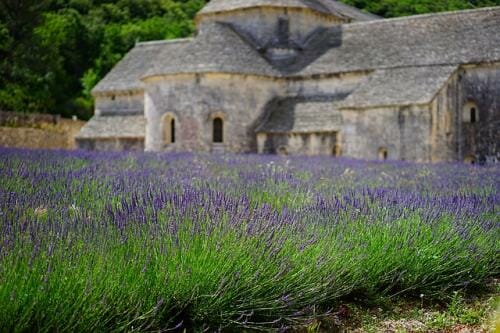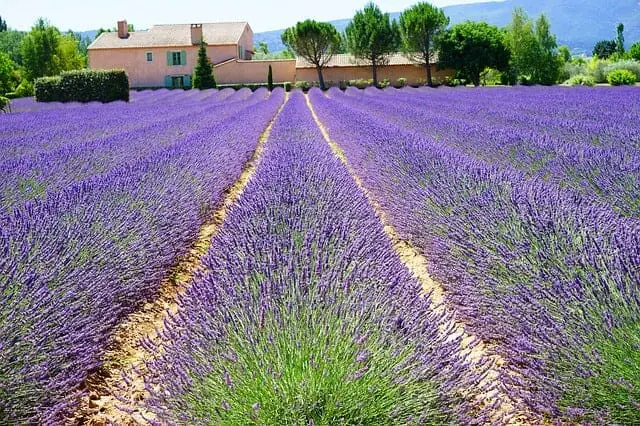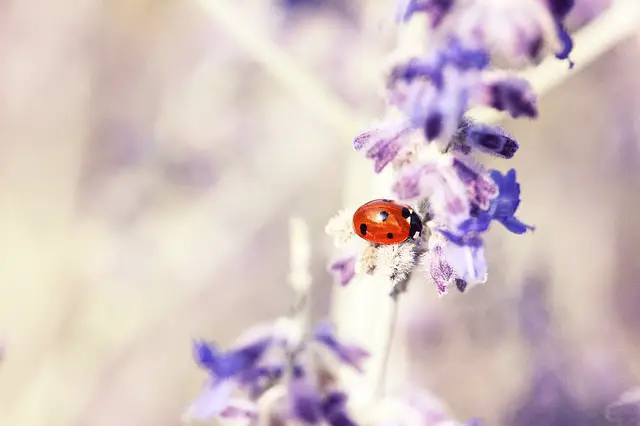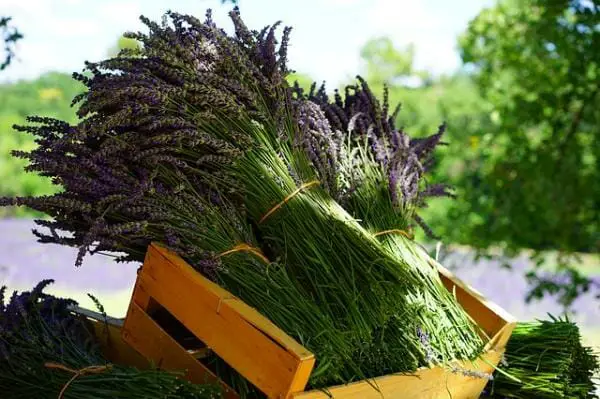Do you want to start a lavender farm for a small scale business? Find here lavender farming guide including seasons, seeding, required equipment, caring, harvesting, and more.
Lavender farming is one of the most profitable crops that you can grow in your backyard garden.
This plant grows well under the sun in dry climates. Lavender seed or cutting planting season starts in spring or fall. Where, if you are a beginner, pick spring when soil is warming up. The whole cultivation process is straightforward. You can begin to grow them immediately if you have a few extra spaces and the appropriate growing conditions.
Let’s learn how you will start growing lavender and care for them to get the most profit. This article will cover all the basic to advanced topics that you ever need to know.
Lavender Farming Guide for Beginners:

Lavender is a beautiful perennial shrub or herb from the Mediterranean climates. Even if you are a complete beginner, you can either start by planting cuttings or seeds.
But, the seed germination process is somewhat complicated. The seed plantation is risky and time-consuming. More or less, it will take about five-week to germinate. At the same time, the seedling will take about six months to become transplantable.
So, when you are planting in a small area, we recommend you to use cuttings. The propagation rate from cutting is higher. Besides, in this method, you can ensure the new plant will be as like parents.
Now,
When you are starting out a lot of factors needed to focus on.
- How and when to start?
- Soil type, structure, PH, and climate requirements.
- Profitable lavender species
- How to create a business plan for a farm
- Keys to growing lavender successfully
- Planting,
- Mulching,
- Pruning,
- Irrigation, Drainage & Overwintering,
- Fertilizers,
- Tools and equipment for lavender farming
- Common pests and diseases and controlling process
- Harvesting Process
- Drying, Preserving & Storing
In this complete farming guideline, we will cover all the topics. But to begin with, let’s start with some basic FAQs and then dig into the growing procedure.
How to Grow Lavender?
Lavender loves sunny and hot weather (not too much), with sufficient sunlight for a least 6 hours a day. The winter is also essential to produce the greatest flower head. Learn more about the required weather and climate.
As we have mentioned earlier, the cultivation of lavender for profit can start through seeds or cuttings. It can cover by a light layer of sifted soil. But growing from seeds is require much effort and knowledge. If you are a beginner to lavender cultivation, you should use cuttings.
Through seeds:
Lavender seeds can sow directly in the place where they will grow or in trays. The lavender transplant complete when the seedlings are large enough to handle. The seeds usually germinate in five weeks. However, it needs six months more for transplanting.
Besides, the nature of the plant can be different from the parents. In the long run, it can fail to ensure profit.
Hence, you can go for germinating lavender seeds in paper towels.
Cutting:
For a commercial farm, it is profitable. So, you can pick cutting from a nearby nursery. There are two types of cutting hardwood or softwood available in most nurseries.
However, which one to pick will depend on two things. One, the plantation session, and two, species.
The softwood cutting is taken from new soft, pliable tips. They are suitable for spring plantations, as they grow roots much faster.
Where the hardwood are taken from mature, thicker resists bending.
But, this type of cutting can be planted in both spring and fall. Though the roots don’t grow faster but they are more reliable.
Now, how you can cut lavender stems for plantation?
To plant lavender first you must cut the stems. Cut about 10 cm long stem.
Then eliminate the leaves are in the lower part. Because it will bury in the ground. The soil should keep slightly humid.
Since an excess of water can lead to the decomposition of the cutting. The space that should be left between the plants varies from 30 to 90 cm.
Essential tools for cultivating lavender:
Like other farms, lavender farming requires some tools and equipment. The following Essential tools commonly used in Lavender plantation.
- Lavender Sifter
- Sharp Sickle
- Mini plow
- steel shank
- A folding hand saw
- kneeling pad
- washable gloves
Why Start Growing Lavender on Your Farm?
Lavender flower farming is known as the most profitable commercial crop. The flower so looks beautiful in your garden. If your passion is gardening, this should be on top of your plants’ list as it is the easiest thing to grow.
They can grow in many conditions, but they shine in well-drained soil and warm climates. This is a common type of any herb nursery. Now, if you are wondering why this flower is profitable? Dig to the next section to find their usages and how you can make money from growing.

Common Usage: How you’ll Make Money?
Now, to encourage yourself lavender farming. Learning about how you can earn can be crucial. It will also aid while creating a business plan.
There are many lavender products. It produces better quality essential oil—the flowers used as a source of food for honey-producing bees. Honey is having with this plant as one of the best quality nectars.
The flowers are also used to give flavor and aroma. In smaller quantities, the leaves are used in wine and vinegar for this purpose to gain scent.
Usually, the fresh flower is processed as oil or medicine. So, it would help if you delivered this flower faster. This farm business is relatively more successful, but it will need one year time to become profitable.
There are lots of other option to make money-
- Lavender blossoms are indispensable parts of cake decoration.
- Dried lavender is demandable among bath products, lotion, chefs, bakeries and bartenders, and candle makers.
- It is commonly used to produce high-quality sugar, vinegar, wands, sachets.
- Besides, the farm itself can be a beautiful tourist place.
Lavender Farming Business Plan
In general, their productive life is about ten years. However, you will hardly get any yield in the first year. That is why you will need a long term business plan.
- You can start with market research, how demandable they are in your locality.
- Secondly, you need to select profitable species and land.
- It’s time to calculate the immediate cost by adding up the approximate costing plus 10%.
- The primary cost will include the cost for – land preparation, equipment, cutting, and other related expenses.
- When you have started, let the community know. You can share this journey in your social profile.
Lavender Farming Conditions- Where do they Grow Best?
These herb plants don’t grow everywhere in the world. They are sensitive to growing conditions.
Climates
This plant grows in a relatively dry climate. It is quite tolerant of different temperatures. However, it is not able to develop properly in very humid or cold climates. The cultivation of this plant needs direct sunlight at least for a minimum of 6 to 8 hours exposure of sun daily.
Lavender prefers direct exposure to the sun. It can also be in semi-shade. Lavender prefers to cultivate it in warm and quite dry climates, mild winters and sunny summers.
It must have good drainage to avoid constant humidity. Soil temperatures should be above 18 ° C favors growth.
Its optimum cultivation temperature is between 15 and 30 ºC. The extra humidity favors the growth of fungal diseases. The overheat of summer affects badly on the quality of the products.
Where Does Lavender Grow?
- Lavender farming conditions suggest you can grow this in the USA, UK, Australia, South Africa, India, Africa, Indonesia, and many other countries…
- From old farming days, this grows in the Canary Islands, Cape Verde.
- The lavender is a relatively rustic plant that can adapt well to different environments. Therefore, the cultivation of lavender can be a good option for people.
- Lavender grows in Southern Europe, Europe beyond to northern and North Africa.
- Southwest Asia to southeast India, eastern Africa, the Mediterranean.
- Some other countries where it produced such as Bulgaria, central Mexico, Span, French, Goodwin Creek.
USA Growing Zones
This flowering crop thrives in the arid West, as annuals, or in the South, In Zones 5 to 9.
When you start lavender farming, you have to learn the best farming method and make notes to follow them later.
Here we designed this as the complete guide. First, we explain how you will prepare the soil. Then the planting or seeding & cutting process with some secret tips. In the care section, we try to focus on available care irrigation, weeding, drainage, etc.
Before the harvesting procedure, a list of common past and decrease are included. However, we do not have a complete guide past and decrease control. Because controlling them is easy. If you want to learn about it, let us know in a comment on this post.
Now, Let’s start by learning the lavender farming information and procedures.
Soil Requirement and Preparing Proces
The profitability of your lavender farming mostly depends on the soil. Successful lavender producers usually spend considerable time on research. So, the perfect ground for a commercial farm should have a pH between 6.5 and 7.5. The calcareous type is the ideal type of soil.
Note:
Lavender thrives in well-drained, sandy, gravel-laden soil. Dig the ground at least between 18 and 24 inches deep. You have to lift the stratum at least six inches.
It recommends using a mixture of 1/3 sand, 1/3 clay, and 1/3 loam to do this.
However, many of the hybrid lavender species produce sterile seeds. In those cases, use soil with well-drained, light, and moderately fertile.
Profitable Lavender Species
- Spanish Lavender (L. stoechas) – Blueberry, Tiara, and Hazel
- Lavandin (L. hybrida, L. x intermedia)-Gros Blue (Dmandable in Frashed, Dried), Super (Shop), Grosso (Oil)
- English Lavender (L. augustifolia) – Buena Vista (culinary), Munstead (lilac-colored & fragrant), and Hidcote.
- Wooly Lavender (L. lanata)
- Spike (L. latifolia)
How to Plant Lavender- Start your Plants from Soft Woodcutting.
You should never try to plant your lavender from the seed. Start your plants from cuttings look at the resource link. That refers to the herbs grow from these. This process could be tedious and frustrating. It is best to order the plants in a nursery.
- Leave a space between the plants 2 1/2 feet with four feet between the rows.
- This should offer you space to plant approximately 4000 plants per acre.
- Surround each plant with the garden cloth. Mulch it and the rows to avoid weeds.
- Surround the base of each plant with a lightly colored hoop. Like pieces of marble, sand, or gravel. This reflects sunlight on the plant.
- Keeping it dry and preventing moisture from causing problems related to it.
Planting Season – When to Plant Lavender
As for the ideal time to lavender farming, you must consider first. The simple answer is spring and fall.
It usually plants in the seedbed at the beginning of spring. It transplants in autumn or winter. When it has already germinated and grown a little. You can decide to obtain a new lavender plant from a segment.
The ideal time to separate the chosen branch is at the end of summer. At the time, the flowering process has finished.
Lavender Care – Caring for High Yield and Profit
“If the care is good, then the yield is good.” Like others, lavender farming needs some care. It only requires a lot of sun heats and little rain. Furthermore, It adapts to any soil and in the fall.
- You must remove those invasive plants as they compete for resources and nutrients.
- You should also periodically remove old branches. That becomes woody to keep the plant healthy. Comprehensive for making borders lavender is easy to grow.
- To reproduce the lavender, we can do it by dividing the plant, cuttings, or seeds.
- It is necessary to have good drainage to avoid puddles, affecting their growth and even rotting their roots.
- That corresponds to a specific genus of warm and temperate climates.
- Lavender needs drastic pruning so that it returns to bloom the following year.
Drip irrigation for lavender fields
Too much moisture on lavender can cause a variety of problems. Aerial irrigation causes plants to split in half. Lavender is also prone to rotting if the soil remains too moist. Plan while you wait for your lavender plants to settle down. Start planning the other aspects of your business.
It would help if you talked to other farmers who have experience in this area. They have learned valuable lessons with expertise. They can offer interesting insights. Enjoy your beautiful grass fields, fragrant, and romantic. All the adorable things you do about it.
Proper irrigation for the lavender plants
This plant is susceptible to excess water. It is for this reason that a tip on how to grow lavender. For lavender, the plant does not need much watering. Rather the opposite. We should stay short of water. It can withstand droughts well enough for us to get through the water.
This is to keep the soil slightly humid. This becomes of particular interest during the initial phase of growth. Once well developed, the lavender crop resists drought. That can irrigate in smaller quantities.
Here are some tips on irrigation:
- Young seedlings require an artificial water supply for developing roots.
- However, from the age of 2 years, it may not require irrigation if the yearly rainfall is over 450 mm.
- Irrigate before and after the flowering period ( once per week, 20 minutes till 1-2 months before harvest)
- To avoid stress in summer (no rain) you sound use 2-4 irrigation sessions.
Common Pests and Diseases
Lavender is repellent of some of the most common pests and insects. It is never wrong to have a few of these plants in your garden. Watering the plants with an infusion prepared with these species will increase their resistance to possible pests.

You see, the plants have their spinach, like Popeye. The cultivation of lavender can attack by different pests and diseases. If you want to succeed in lavender farming, it’s better to prevent than to cure. Therefore, before any sign of attack on the plant, it is better to eliminate the affected parts.
The plant can be affected by:
- Slugs
- Whiteflies.
- Mites
- Con chinchillas
Controlling Pests and diseases
- You can keep the aromatic plant in pots to keep away insects and use it as a repellent spray. Basil and garlic are useful when repelling flies, insects, and fungi. That is why it never hurts to put a pot.
- If even with some of these resources, our plants are victims of a plague. It will be best to eliminate the infected or dead plants as soon as possible. This is to prevent it from spreading among the rest of our specimens.
Harvesting Process- Lavender Harvesting Guide
For harvesting, the entire branch must cut with the flower and leaves. The leaves can remove at any time. You have to use sharp flower cutting tools.

However, they are considered not only flowers but also herbs. People extract essential oils from the freshly chopped flowers. But, This plant grows relatively slowly. Though, It blooms in the first year. But, the most abundant flowering begins after the second year of cultivation.
Finally, if you are thinking of starting lavender farming, I will say, “go for it.” But this will need a lot of time and afford to become a successful gardener. On the other hand, this top-priced priced flower to grow.
Thanks! I will be extremely pleased if I can help you. If you have any questions regarding this article, please comment below. And don’t forget to share this article with your friends as we are still growing. Happy Levander Farming.

I need project report of lavender in India.
Thanks!
Thanks! its a complete guide line for me
This is awesome
Awesome Guide! thanks
I want plant lavender for organic oil please advice on it
You can follow this guide.
You can follow this guide.
Thanks for the guide
Hi
I have been doing research for some time now, I am very intressted to start a lavender bussiness and would be so gald if you can help to get me started and where to go to begin.
Kind regards
I would feel proud too, you can start by this-
Firstly, gather information and list out things to do, and it will be perfect if you can create a business plan including cost and others…
The farming process is like that…
1. choose land and prepare, in the meantime collect lavender seedlings.
2. learn about fertilizer and care
3. keep performing good practices on gardening
4. learn about harvesting
Hi,
Thank you for this information.
We will be starting our farm in the spring and are trying to get every thing in place to succeed.
Diane
Villa Lavender
It sounds perfect. Be good luck with you.
Thank you so much with information
I am in retested in starting farming in lavender for profit and kindly advise on Equipments and method on a five hectors.
Can you recommend a supplier to purchase organic seedlings from preferably in Canada? This is a new venture for us.
Thank you, with gratitude
Welcome! Hope you are doing well. Here is a list of organic seed suppliers in ca certified by Canadian Organic Growers.I am not associated with them, so I can’t tell in detail. However, You can contact them to know more information.
Hi
I am doing some research on lavender to find out if it something that can be grown on a large scale in California and is profitable. I have some more question regarding growing lavenders, please can you email me so I can clear some of my doubts.
Thank you